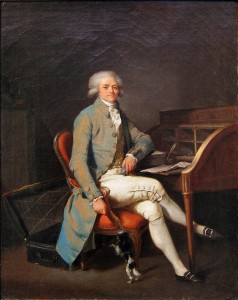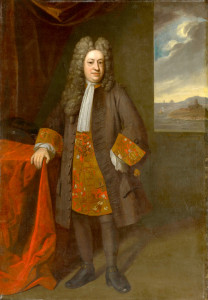The outbreak of the French Revolution’s Reign of Terror was cast on 17 September 1793 when the Law of Suspects was passed (it was a decree rather than a law). Up until then, the arrests, trials, and executions had been mere footnotes.
Committee of Public Safety
Now here is the ultimate oxymoron. This committee was first set up in April 1793 for the purpose of “protecting the newly established republic against foreign attacks and internal rebellion.” By July 1793, the committee was acting as the de facto French government and its citizen’s rights were about to become severely compromised.
The committee’s twelve members were given broad powers over military, judicial, and legislative issues. Maximilien Robespierre (1758–1794) and his radical right hand man, Louis Saint-Just (1767–1794), were appointed to the committee in July 1793 following the elimination of the moderate Girondins.


Between December 1793 and July 1794, the Committee of Public Safety ran the country under Robespierre’s “dictatorship.” It was responsible for four major decrees: Levée en masse (mass-conscription to fight the Revolutionary Wars), Law of the Maximum (price controls), Law of Revolutionary Government (centralized authority in a dictatorship), and the Law of Suspects.
The Law of Suspects
The Committee of Public Safety passed the Law of Suspects in September 1793, one month before Marie Antoinette was tried. The decree pretty much eliminated individual freedoms and contributed to the fear and paranoia that became the Reign of Terror between September 1793 and July 1794.
Anyone could be arrested, tried, and punished based only on the suspicion of being “notoriously suspected of aristocracy and bad citizenship.” The aristocracy connection wasn’t new but the bad citizenship label was. Denouncements about being a bad citizen and enemy of the Revolution became commonplace. People were turned in to the authorities because the accuser might have an axe to grind. Or perhaps the accuser had an economic interest in denouncing a person. Most of the accusations had nothing to do with actual crimes.
Research into the historical records has indicated that more than 500,000 people were arrested and tried under the Law of Suspects with approximately 50,000 casualties, of which 16,594 were executed (it is estimated that more than 40,000 people perished during the Reign of Terror). At the time, there were 28 prisons in Paris. As a result of the Law of Suspects, the prison population in Paris swelled to the point where the overflow of prisoners were put under house arrest.
France 2016
One of the reasons I’ve written this blog is to point out some familiarities that the Revolution shares with current events. There is no greater example than what is happening in France today with respect to the National Front Party and comments made by its leader, Marine Le Pen.

As many of us know, France has experienced some of the most horrific acts of terrorism on its soil. The government is struggling with how to prevent future terrorist acts from occurring again.
Marine Le Pen has called for the deportation of any foreigner “simply suspected of any sort of link with terror.”1
I’m not trying to advocate anything here other than to say her comment reminded me of the Law of Suspects passed during the French Revolution and its ultimate effect.
1 – Bloomberg News, Gregory Viscusi – 3 August 2016.
World War II – Nazi Occupation
We will visit the concept of being arrested on suspicions again. It raises its ugly head during the Nazi occupation of Paris. People were always afraid of being denounced and reported to the Gestapo. Many instances were based on suspicions of a third party. The unfortunate person would be taken to one of the Gestapo offices and interrogated (most resulted in torture). The end result was being released or deported to a concentration camp.
Yale University
Roger Kimball writes in the Wall Street Journal (8 August 2016) about Yale University and some of the similarities to the French Revolution.
The president of Yale recently created the “Committee to Establish Principles on Renaming.” Mr. Kimball points out that during the French Revolution, the calendar was renamed and restarted at zero. The Soviets renamed cities, erased the names of political enemies, and banned scientific theories that didn’t match Marxist doctrine.

Yale also created the new “Committee on Art in Public Spaces” after a janitor smashed and destroyed one of the historical stained glass windows because he didn’t like its depiction of slaves (he was fired but then rehired after the students complained). The committee is to judge whether certain “offensive” art (including stained glass windows) should be permanently removed.
I’m wondering if Yale’s students, professors, and administration will rename the university. You see, Yale University was named after philanthropist and benefactor, Elihu Yale. Mr. Yale was an administrator of India and major slave trader (his policy was to load each of his outbound ships with a minimum of ten slaves). Let’s see what the “Committee to Establish Principles on Renaming” will have to say about that.
Thanks for reading my blog. I’m going to stop here because I suspect I’ve used up too much of your time.
Someone Is Commenting On Our Blogs
I’d like to thank Mark V. for his comments on the Revolution books. He took them to Paris and did the Marie Antoinette walk (volume two – walk one). His suggestions were great and it’s always nice to be complemented.
Keep your comments coming. I love hearing from you.
We Need Your Help
Please tell your friends about our blog site and encourage them to visit and subscribe. Sandy and I are trying to increase our audience and we need your help through your friends and social media followers.
What’s New With Sandy and Stew?
We have worked with some extremely talented people to come up with our new logo. It was necessary to brand Stew Ross, the author as opposed to the corporate entity, Yooper Publications. I hope you like the Stew Ross Discovers™ logo:
We’ve also tried to refine our tag line to more accurately reflect our product:
WALKS THROUGH HISTORY
As part of this refreshing process, we will be working on our blog site to ensure it is updated, professional, easy to navigate, and contain relevant content.
We have a lot of stories and we’re looking forward to sharing these with you. Please continue to visit our blog site and perhaps you’d like to subscribe so that you don’t miss out on our blog posts, past and current.
Find Stew’s books on Amazon and iBooks.
Thank You
Sandy and I appreciate you visiting with us. We have some exciting things on the horizon and we’ll keep you updated as we go along.
Share This:
Follow Stew:
Find Stew’s books on Amazon and iBooks.
Please note that we do not and will not take compensation from individuals or companies mentioned or promoted in the blogs.
Walks Through History
Copyright © 2016 Stew Ross


